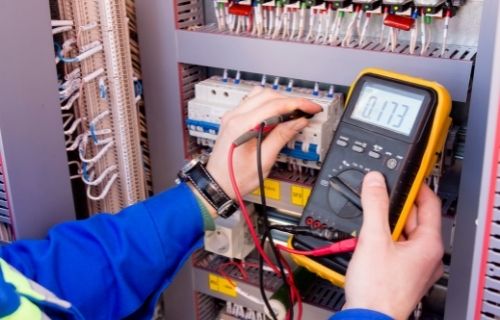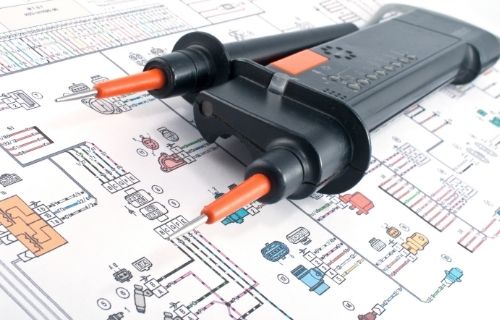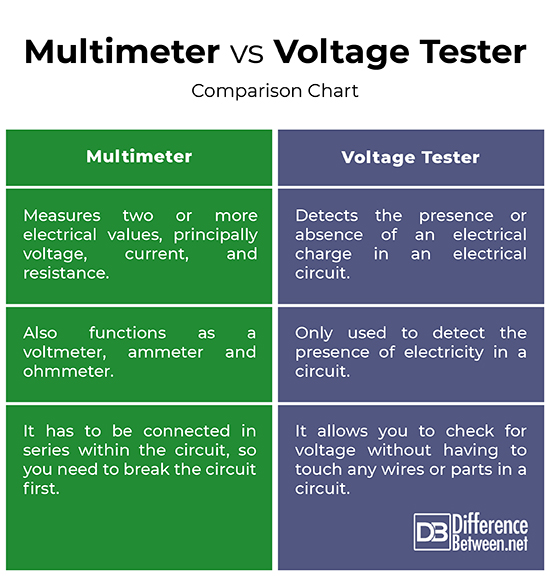Difference Between Multimeter and Voltage Tester
Whether you want to test a simple circuit you’ve made for your school’s science project or a faulty appliance in your home or a wall outlet, there are several testing tools that can be used. A voltage tester is probably the simplest of all testing tools used to measure the flow of electrical current. A multimeter is yet another multipurpose tool that provides a wide range of other electrical testing uses.

What is a Multimeter?
A multimeter is a standard diagnostic and troubleshooting tool for technicians in the electrical/ electronic industries. It is a handheld testing device used to measure two or more electrical values, principally voltage (volts), current (amps), and resistance (ohms). It is also a common household testing tool used to check faulty appliances for some defects in their electrical circuits or components. It looks for electrical resistance within a circuit, but can be used to check multiple electrical properties. Almost all multimeters can measure voltage, current, and resistance.
More advanced multimeters might have other functions, such as the ability to measure other values like capacitance, transistor gain, or diode forward voltage. Multimeters can be analog or digital. Analog multimeters use a needle along a scale to test electrical instruments, whereas digital multimeters use an LCD to directly display the value. There’s yet another type of multimeter called auto-ranging type which, as the name suggests, sets the test range automatically. You have to spend some extra bucks for the auto-ranging type though.

What is a Voltage Tester?
A voltage tester, also known more commonly as voltage detector, is a simple electrical testing tool that checks for presence or absence of an electrical charge in an electrical circuit or component. It is mainly a pen-shaped testing instrument used for electrical power testing uses. The device detects the electrical field generated by voltage on a wire or other electrical system to check if the wire or a system is energized with an electrical potential. It can be an easy-to-use hardware that detects the presence of electricity or a more advanced tool to detect precise voltage levels in an electrical system.
A non-contact voltage tester is also used to quickly verifying that a circuit is energized or deenergized. However, it should not replace voltmeter testing to prove that a circuit is deenergized for safety reasons. Non-contact voltage testers are relatively small, battery-powered devices that easily fit in your pockets. They typically have an on/off button, a flashlight or indicator, a high-intensity LED light, a battery indicator, and a built-in self-test feature. These are also available in several voltage ranges. However, these are not meant for sensing the presence of DC voltage.
Difference between Multimeter and Voltage Tester
Function
– A multimeter is a multi-purpose electrical testing tool used to measure two or more electrical values, principally voltage (volts), current (amps), and resistance (ohms). It also functions as a voltmeter, ammeter and ohmmeter. Almost, all multimeters can measure voltage, current and resistance. A voltage tester is a simple electrical testing tool used to detect the presence or absence of an electrical charge in an electrical circuit or component.
Working
– A multimeter looks for very low resistance to see if two points are connected. It does that by injecting a small current into the circuit and then taking a reading of the voltage drop across those points in the electrical circuit. The voltage drop is then used to calculate the resistance. A simple neon voltage tester has two wire leads with a metal probe on each end. The wire probes need to be in contact with the wires; one probe touches the hot wire and the other one goes to neutral. If there is current present, the neon bulb will light up.
Safety
– A multimeter has to be connected in series within the circuit, which means you need to break the circuit first. It is a relatively lengthy process and requires proper handling. It can be a bit risky to operate, if not handled by professional electricians. A voltage tester, particularly a non-contact voltage tester, is a simple, battery-powered voltage testing tool that is the easiest and the safest to use. It allows you to check for voltage without having to touch any wires or parts in a circuit.
Multimeter vs. Voltage Tester: Comparison Chart

Summary
There are a lot of different types of testers that the electricians use for various different purposes. Non-contact voltage testers are probably the easiest and safest to use testing tools that detect the presence of voltage in a circuit without you having to touch any wires. However, these are not accurate at all the times and sometimes, they show false readings. Multimeters are multipurpose testing tools that can be used to measure two or more electrical values, principally voltage (volts), current (amps), and resistance (ohms).
What is the difference between a voltage tester and a voltmeter?
If you need to measure voltage, then a voltmeter is sufficient. A voltmeter is used to measure the potential difference (or voltage) between two points in electrical circuits. A voltage tester is a simple tool used to detect the presence of electricity in a piece of electrical equipment.
What is a voltage tester used for?
A voltage tester is a simple handheld testing tool used for electrical power testing uses.
Can you use a multimeter as a voltmeter?
Yes. A multimeter is a multipurpose testing tool that also functions as a voltmeter, ammeter and ohmmeter.
Can a multimeter check voltage?
A multimeter is a testing instrument that can be used to measure multiple electrical properties, including voltage.
- Difference Between Caucus and Primary - June 18, 2024
- Difference Between PPO and POS - May 30, 2024
- Difference Between RFID and NFC - May 28, 2024
Search DifferenceBetween.net :
Leave a Response
References :
[0]Miller, Charles R. Ugly’s Electrical References, 2020 Edition. Massachusetts, United States: Jones & Bartlett Learning, 2019. Print
[1]Gill, Paul. Electrical Power Equipment Maintenance and Testing. Florida, United States: CRC Press, 2016. Print
[2]Kind, Dieter and Kurt Feser. High Voltage Test Techniques. London, United Kingdom: Newnes, 2001. Print
